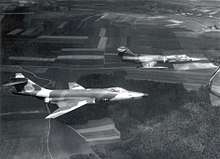Lockheed F-104 Starfighter
| F-104 Starfighter | |
|---|---|
.jpg) | |
| The XF-104 Starfighter prototype | |
| Role | Interceptor aircraft, fighter-bomber |
| National origin | United States |
| Manufacturer | Lockheed |
| First flight | 17 February 1956 (YF-104A) |
| Introduction | 20 February 1958 |
| Retired | 31 October 2004 (Italy) |
| Status | Retired from military service; in use with civilian operators as warbirds |
| Primary users | United States Air Force German Air Force Japan Air Self-Defense Force Turkish Air Force |
| Number built | 2,578 |
| Unit cost |
US$1.42 million (F-104G)[1] |
| Developed from | Lockheed XF-104 |
| Variants | Lockheed NF-104A Canadair CF-104 Aeritalia F-104S |
| Developed into | Lockheed CL-1200/X-27 Lockheed CL-288 |
The Lockheed F-104 Starfighter is a single-engine, supersonic interceptor aircraft which later became widely used as an attack aircraft. It was originally developed by Lockheed for the United States Air Force (USAF), but was later produced by several other nations, seeing widespread service outside the United States. One of the Century Series of fighter aircraft, it was operated by the air forces of more than a dozen nations from 1958 to 2004. Its design team was led by Kelly Johnson, who contributed to the development of the Lockheed P-38 Lightning, Lockheed U-2, Lockheed SR-71 Blackbird and other Lockheed aircraft.[2]
The F-104 set numerous world records, including both airspeed and altitude records. Its success was marred by the Lockheed bribery scandals, in which Lockheed had given bribes to a considerable number of political and military figures in various nations to influence their judgment and secure several purchase contracts; this caused considerable political controversy in Europe and Japan.
The poor safety record of the Starfighter also brought the aircraft into the public eye, especially in German Air Force service. Fighter ace Erich Hartmann was forced to retire from the Luftwaffe due to his outspoken opposition to selection of the F-104.
The final production version of the fighter model was the F-104S, an all-weather interceptor designed by Aeritalia for the Italian Air Force, and equipped with radar-guided AIM-7 Sparrow missiles. An advanced F-104 with a high-mounted wing, known as the CL-1200 Lancer, was considered, but did not proceed past the mock-up stage.
Development
Background and early development
Clarence "Kelly" Johnson, the chief engineer at Lockheed's Skunk Works, visited Korea in December 1951 and spoke with fighter pilots about what sort of aircraft they wanted. At the time, the U.S. pilots were confronting the MiG-15 with North American F-86 Sabres, and many felt that the MiGs were superior to the larger and more complex American design. The pilots requested a small and simple aircraft with excellent performance.[3] Armed with this information, Johnson immediately started the design of such an aircraft on his return to the United States. In March, his team was assembled; they studied several aircraft designs, ranging from small designs at 8,000 lb (3,600 kg), to fairly large ones at 50,000 lb (23,000 kg). To achieve the desired performance, Lockheed chose a minimalist approach - a design that would achieve high performance by wrapping the lightest, most aerodynamically efficient airframe possible around a single powerful engine. The engine chosen was the new General Electric J79 turbojet, an engine of dramatically improved performance in comparison with contemporary designs. The small L-246 design powered by a single J79 remained essentially identical to the L-083 Starfighter as eventually delivered.[3]
The design was presented to the Air Force in November 1952, and they were interested enough to create a General Operating Requirement for a lightweight fighter to replace the North American F-100. Three additional companies replied to the requirement: Republic Aviation with the AP-55, an improved version of its prototype XF-91 Thunderceptor; North American Aviation with the NA-212, which eventually evolved into the F-107; and Northrop Corporation with the N-102 Fang, another J79-powered design. Although all were interesting, Lockheed had what proved to be an insurmountable lead, and was granted a development contract in March 1953 for two prototypes; these were given the designation "XF-104".[4]
Work progressed quickly, with a mock-up ready for inspection at the end of April, and work starting on two prototypes late in May. Meanwhile, the J79 engine was not ready; both prototypes were instead designed to use the Wright J65 engine, a licensed-built version of the Armstrong Siddeley Sapphire. The first prototype was completed by early 1954 and first flew on 4 March at Edwards AFB. The total time from contract to first flight was less than a year.[5]
When the USAF revealed the existence of the XF-104, they only gave a vague description of it. A drawing in the August 1954 edition of Popular Mechanics was very close to the actual design.[6]
The prototype had hopped into the air on 18 February, but that was not counted as a first flight. On the first official flight, it experienced landing gear retraction problems. The second prototype was destroyed a few weeks later during gun-firing trials, but in November 1955, the XF-104 was accepted by the USAF.
Further development
Based on the XF-104 testing and evaluations, the next variant, the YF-104A, was lengthened and fitted with a General Electric J79 engine, modified landing gear, and modified air intakes.[7]
The first YF-104A flew on 17 February 1956, and with the other 16 trial aircraft, were soon carrying out aircraft and equipment evaluation and tests. Modifications were made to the aircraft including airframe strengthening and adding a ventral fin. Problems were encountered with the J79 afterburner; further delays were caused by the need to add AIM-9 Sidewinder air-to-air missiles. On 28 January 1958, the first F-104A to enter service was delivered to the 83rd Fighter Intercepter Wing.[8]
A total of 2,578 F-104s was produced by Lockheed and under license by various foreign manufacturers.[9]
Design
Airframe
The F-104 featured a radical wing design. Most jet fighters of the period used a swept-wing or delta-wing design, which provided a reasonable balance between aerodynamic performance, lift, and internal space for fuel and equipment. The Lockheed tests, however, determined that the most efficient shape for high-speed supersonic flight was a very small, straight, mid-mounted, trapezoidal wing.

The new wing design was extremely thin, with a thickness-to-chord ratio of only 3.36% and an aspect ratio of 2.45. The wing's leading edges were so thin (.016 in, 0.41 mm) that they presented a cut hazard to ground crews: protective guards had to be installed on the edges during ground operations maintenance.[10] The thinness of the wings required fuel tanks and landing gear to be placed in the fuselage, and the hydraulic cylinders driving the ailerons were limited to 1-inch (25 mm) thickness to fit.
The small, highly loaded wing resulted in an unacceptably high landing speed, even with both leading- and trailing-edge flaps installed. As a result, the aircraft designers developed a boundary layer control system (BLCS) of blown-flap bleed air over the trailing-edge flaps to help lower landing speeds, making landings safer.[10] The system proved to be a maintenance problem in service, however, and landing without the BLCS engaged could be a harrowing experience.[11]
The stabilator (horizontal tail surface) was mounted atop the fin to reduce inertia coupling. Because the vertical fin was only slightly shorter than the length of each wing and nearly as aerodynamically effective, it could act as a wing on rudder application, rolling the aircraft in the opposite direction of rudder input. To offset this effect, the wings were canted downward, giving 10° anhedral.[11]
The fuselage had a high fineness ratio, i.e. slender, tapered towards the sharp nose, and a small frontal area. The tightly packed fuselage contained the radar, cockpit, cannon, fuel, landing gear, and engine. The fuselage and wing combination provided low drag except at high angle of attack (alpha), at which point induced drag became very high. The F-104 had good acceleration, rate of climb, and potential top speed, but its sustained turn performance was poor.
Engine
The F-104 was designed to use the General Electric J79 turbojet engine,[12]fed by side-mounted intakes with fixed inlet cones optimized for supersonic speeds. Unlike some supersonic aircraft, the F-104 did not have variable-geometry inlets, instead at high mach numbers excess air is bypassed around the engine. This bypass air also helps cool the engine. The F-104 had an excellent thrust-to-drag ratio, allowing a maximum speed well in excess of Mach 2.[13]
Ejection seat
Early Starfighters used a downward-firing ejection seat (the Stanley C-1), out of concern over the ability of an upward-firing seat to clear the "T-tail" empennage. This presented obvious problems in low-altitude escapes, and 21 USAF pilots, including test pilot Capt. Iven Carl Kincheloe Jr., failed to escape from their stricken aircraft in low-level emergencies because of it. The downward-firing seat was replaced by the Lockheed C-2 upward-firing seat, which was capable of clearing the tail, but still had a minimum speed limitation of 104 mph (167 km/h). Many export Starfighters were later retrofitted with Martin-Baker Mk.7 "zero-zero" (zero altitude and zero airspeed) ejection seats.[14]
Avionics
The initial USAF Starfighters had a basic AN/ASG-14T ranging radar, tactical air navigation system (TACAN), and an AN/ARC-34 UHF radio.
In the late 1960s, Lockheed developed a more advanced version of the Starfighter, the F-104S, for use by the Italian Air Force as an all-weather interceptor. The F-104S received a NASARR R21-G with a moving target indication and a continuous-wave radar illuminator for semi-active radar homing missiles, including the AIM-7 Sparrow and Selenia Aspide. The missile-guidance avionics forced the deletion of the Starfighter's internal cannon. In the mid-1980s, surviving F-104S aircraft were updated to ASA standard (Aggiornamento Sistemi d'Arma, or Weapon Systems Update), with a much improved, more compact FIAR R21G/M1 radar.
Armament
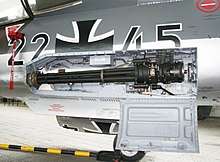
The basic armament of the F-104 was the 20 mm (0.79 in) M61 Vulcan autocannon. As the first aircraft to carry the weapon, testing of the Starfighter revealed issues with the initial version of the M61: the Gatling-mechanism cannon suffered problems with its linked ammunition, being prone to misfeed and presenting a foreign object damage (FOD) hazard with discarded links. A linkless ammunition feed system was developed for the upgraded M61A1 installed in the F-104C; the M61A1 has subsequently been used by a wide variety of American combat aircraft.[15]
The cannon, mounted in the lower part of the port fuselage, was fed by a 725-round drum behind the pilot's seat. With its firing rate of 6,000 rounds per minute, the cannon would empty the drum after just over 7 seconds of continuous fire.[16] The cannon was omitted in all the two-seat models and some single-seat versions, including reconnaissance aircraft and the early Italian F-104S, with the gun bay and ammunition tank typically replaced by additional fuel tanks.[17] The gun's location was advantageous as gun-flash was not in the pilot's line of sight, therefore not robbing him of night-adjusted vision.
Two AIM-9 Sidewinder air-to-air missiles could be carried on the wingtip stations, which could also be used for fuel tanks. The F-104C and later models added a centerline pylon and two underwing pylons for bombs, rocket pods, or fuel tanks; the centerline pylon could carry a nuclear weapon.[16] A "catamaran" launcher for two additional Sidewinders could be fitted under the forward fuselage, although the installation had minimal ground clearance and rendered the seeker heads of the missiles vulnerable to ground debris. The F-104S models added a pair of fuselage pylons beneath the intakes available for conventional bomb carriage and an additional pylon under each wing, for a total of nine.[18]
Operational history
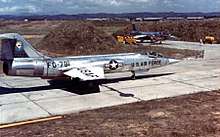
U.S. Air Force

The F-104A initially served briefly with the USAF Air Defense Command (ADC) as an interceptor, although neither its range nor armament were well-suited for that role. The first unit to become operational with the F-104A was the 83rd Fighter Interceptor Squadron on 20 February 1958, at Hamilton AFB, California. After just three months of service, the unit was grounded after a series of engine-related accidents. The aircraft were then fitted with the J79-3B engine and another three ADC units equipped with the F-104A. The USAF reduced their orders from 722 Starfighters to 155.[19] After only one year of service these aircraft were handed over to ADC-gained units of the Air National Guard; the F-104 was intended as an interim solution while the ADC waited for delivery of the Convair F-106 Delta Dart.[20]
During the Berlin Crisis of 1961, President John F. Kennedy ordered 148,000 United States National Guard and reserve personnel to active duty on 30 August 1961, in response to Soviet moves to cut off Allied access to Berlin. 21,067 individuals were from the Air National Guard (ANG), forming 18 fighter squadrons, four reconnaissance squadrons, six transport squadrons, and a tactical control group. On 1 November 1961, the USAF mobilized three more ANG fighter interceptor squadrons. In late October and early November, eight of the tactical fighter units flew to Europe with their 216 aircraft in "Operation Stair Step". Because of their short range, 60 F-104As were airlifted to Europe in late November, among them the 151st FIS and 157th FIS. The crisis ended in the summer of 1962, and the personnel returned to the United States.[21]
The subsequent F-104C entered service with USAF Tactical Air Command (TAC) as a multi-role fighter and fighter-bomber. The 479th Tactical Fighter Wing at George AFB, California, was the first unit to equip with the type in September 1958. Although not an optimum platform for the theater, the F-104 did see limited service in the Vietnam War. In 1967, these TAC aircraft were transferred to the Air National Guard.
Vietnam War
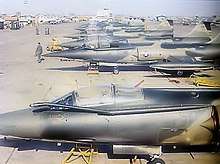
Starfighter squadrons made two deployments to Vietnam. Commencing with Operation Rolling Thunder, the Starfighter was used both in the air-superiority role and in the air support mission, and although it saw little aerial combat and scored no air-to-air kills, F-104s were successful in deterring MiG interceptors.[22] During the first F-104 deployment from April to October 1965, Starfighters flew a total of 2,937 combat sorties. These sorties resulted in the loss of five aircraft: the 476th Tactical Fighter Squadron deployed from April to July 1965, losing one Starfighter, and the 436th Tactical Fighter Squadron deployed from July through October 1965, losing four.[23] Two Starfighters were shot down by ground fire, one was shot down by a Shenyang J-6 when Capt. Philip E. Smith strayed into Chinese airspace, and two were lost to a mid-air collision while searching for Smith's missing jet.[24][25][26]
Starfighters returned to Vietnam when the 435th Tactical Fighter Squadron deployed from June 1966 until July 1967. During this time F-104s flew a further 2,269 combat sorties, for a total of 5,206. F-104s operating in Vietnam were upgraded in service with APR-25/26 radar warning receiver equipment, with one example on display in the Air Zoo in Kalamazoo, Michigan.[27] During the second deployment, an additional nine aircraft were lost for a total of 14 F-104s lost to all causes in Vietnam. In July 1967, the Starfighter units transitioned to the McDonnell Douglas F-4 Phantom II.[28][29]
| Date | F-104 model | Unit | Cause of loss/remarks |
|---|---|---|---|
| 6-29-1965 | F-104C | 476th TFS | Shot down by enemy ground fire while providing close air support (CAS).[30] |
| 7-22-1965 | F-104C | 436th TFS | Downed by ground fire while on a CAS mission.[31] |
| 9-20-1965 | F-104C | 435th TFS | Downed by PLAAF MiG-19 (J-6) 30mm cannon fire while on a MIGCAP mission.[32] |
| 9-20-1965 | (2) F-104C | 436th TFS | Mid air collision while conducting air search for earlier PLAAF downed F-104C.[32] |
| 8-01-1966 | (2) F-104C | 435th TFS | (2) F-104Cs downed by SA-2 surface to air missiles while on MIGCAP mission.[33] |
| 9-01-1966 | F-104C | 435th TFS | Downed by anti-aircraft artillery fire (AAA) while on reconnaissance mission.[34] |
| 10-02-1966 | F-104C | 435th TFS | Downed by SA-2 SAM at 10,000 feet while on reconnaissance mission.[35] |
| 10-20-1966 | F-104C | 435th TFS | Downed by ground fire during reconnaissance mission.[36] |
| 01-12-1967 | F-104C | 435th TFS | Operational loss; crashed while landing.[37] |
| 01-16-1967 | F-104C | 435th TFS | Operational loss; engine failure.[38] |
| 01-28-1967 | F-104C | 435th TFS | Operational loss; engine failure.[39] |
| 5-14-1967 | F-104C | 435th TFS | Operational Loss; engine failure.[40] |
Stateside service

The U.S. Air Force was less than satisfied with the Starfighter, and procured only 296 examples in single-seat and two-seat versions. At the time, USAF doctrine placed little importance on air superiority (fighter-to-fighter), and the Starfighter was deemed inadequate for either the interceptor (fighter-to-bomber) or tactical fighter-bomber role, lacking both payload capability and endurance in comparison with other USAF aircraft. The F-104's U.S. service was quickly wound down after 1965. The last USAF Starfighters left regular Air Force service in 1969. The aircraft continued in use with the Puerto Rico Air National Guard until 1975 when it was replaced in that organization by the A-7 Corsair II.[27]
The last use of the F-104 Starfighter in U.S. markings was training pilots for the West German Air Force, with a wing of TF-104Gs and F-104Gs based at Luke Air Force Base, Arizona. Although operated in USAF markings, these aircraft (which included German-built aircraft) were owned by West Germany. They continued in use until 1983.[41]
India–Pakistan Wars
At dawn on 6 September 1965, Flight Lieutenant Aftab Alam Khan of Pakistan claimed an Indian Dassault Mystère IV over West Pakistan and damaged another, marking the start of aerial combat in the Indo-Pakistani War of 1965. It is claimed as the first combat kill by any Mach 2 aircraft, and the first missile kill for the Pakistan Air Force (PAF). Indian sources dispute this claim.[42] The Starfighter was also instrumental in intercepting an Indian Folland Gnat on 3 September 1965. F-104s were vectored to intercept the Gnat flying over Pakistan, which was returning to its home base. The F-104s, closing in at supersonic speed, caused the Gnat pilot to land at a nearby disused Pakistani airfield and surrender. The Indian Air Force (IAF) disputed PAF's claim of forced landing and stated that the landing was an error of the pilot, who made an emergency landing thinking it to be an Indian airstrip. The IAF Gnat is now displayed at the PAF Museum, Karachi.[43][44]
The first direct air-to-air combat engagements between the F-104 and the MiG-21 took place during the Indo-Pakistani War of 1971. MiGs flown by the IAF shot down four PAF Starfighters without sustaining any losses.[45] The first loss occurred on 12 December 1971, when MiG-21FLs of the IAF's No. 47 Squadron shot down a PAF F-104 flown by Wing Commander Mervyn Middlecoat over the Gulf of Kutch. The next three PAF F-104s were all shot down five days later on 17 December, two by IAF MiG-21FLs of No. 29 Squadron over Uttarlai, Rajasthan, and the third by another MiG-21FL of the same squadron later the same day.[46]
Post-war sanctions forced an early retirement of F-104s from the PAF due to lack of maintenance support.[47]
1967 Taiwan Strait Conflict
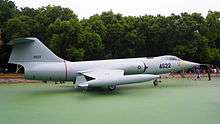
On 13 January 1967, four Republic of China (Taiwan) Air Force F-104G aircraft engaged a formation of 8 MiG-19s of the People's Liberation Army Air Force over the disputed island of Kinmen. Major Hu Shih-lin and Captain Shih Bei-puo each shot down one MiG-19. This marked the first uncontested F-104 combat victory in the world. One F-104 did not return to base and its pilot was listed as MIA.[48]
Other international service
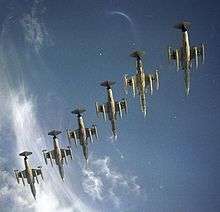
At the same time that the F-104 was falling out of U.S. favor, the German Air Force was looking for a multi-role combat aircraft to operate in support of a missile defense system.[49] In response, Lockheed reworked the Starfighter from a fair-weather fighter into an all-weather ground-attack, reconnaissance, and interceptor aircraft, and presented it as the F-104G. The redesigned aircraft was chosen over the English Electric Lightning, Grumman F11F Super Tiger, and Northrop N-156.[50] The Starfighter found a new market with other NATO countries as well, and eventually a total of 2,578 of all variants of the F-104 were built in the U.S. and abroad for various nations. Several countries received their aircraft under the U.S. government-funded Military Aid Program (MAP). The American engine was retained but built under license in Europe, Canada, and Japan. The Lockheed ejector seats were retained initially but were replaced later in some countries by the safer Martin-Baker seat.
The so-called "Deal of the Century" produced substantial income for Lockheed but the resulting bribery scandals caused considerable political controversy in Europe and Japan. In Germany, Minister of Defence Franz Josef Strauss was accused of having received at least US$10 million for West Germany's purchase of the F-104 Starfighter in 1961.[51] Prince-consort Bernhard of the Netherlands was forced to resign as Inspector-General of the Dutch Armed Forces after being accused of having received more than US$1 million in bribes.
The international service of the F-104 began to wind down in the late 1970s, being replaced in many cases by the General Dynamics F-16 Fighting Falcon, but it remained in service with some air forces for another two decades. The last operational Starfighters served with the Italian Air Force, which retired them on 31 October 2004.[52]
Use as space launch platform
In 2011, 4Frontiers Corporation and Starfighters Inc (a private F-104 operator) began working together on a project to launch suborbital sounding rockets from F-104s flying out of Kennedy Space Center. First launches were expected to occur in 2012.[53][54] As of 16 July 2017, both the 4Frontiers Corporation and Star Lab suborbital websites were unresponsive, and there appeared to be no mention of 4Frontiers or the joint project on the Starfighters Inc website.
In early 2016, another venture, CubeCab, was working on a rocket system that would launch CubeSats from F-104s.[55][56][57] The company said it planned to begin providing launch services "around 2018".[58]
Flying characteristics
The Starfighter was the first combat aircraft capable of sustained Mach 2 flight, and its speed and climb performance remain impressive even by modern standards. Equipped with razor-edge thin-blade supersonic wings (visible from the cockpit only in the mirrors), it was designed for optimum performance at Mach 1.4. If used appropriately, with high-speed surprise attacks and good use of its exceptional thrust-to-weight ratio, it could be a formidable opponent. It was exceptionally stable at high speed, i.e., 600+ knots (1,100+ km/h; 690+ mph) at very low level, making it a potent tactical nuclear strike-fighter. However, when lured into a low-speed turning contest with conventional subsonic opponents (as Pakistani pilots were with Indian Hunters in 1965), the outcome of dogfights was always in doubt. The F-104's large turn radius was due to the high speeds required for maneuvering, and its high-alpha stalling and pitch-up behavior was known to command respect.[59] In reference to the F-104's low-speed turn performance, a humorous colloquialism was coined by a Canadian pilot and referred to by F-104 pilots the world over: "Banking with intent to turn."
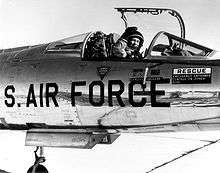
Takeoff speeds were in the region of 219 mph (352 km/h), with the pilot needing to swiftly raise the landing gear to avoid exceeding the limit speed of 299 mph (481 km/h). Climb and cruise performance were outstanding; occasionally a "slow" light would illuminate on the instrument panel at around Mach 2 to indicate that the engine compressor was nearing its limiting temperature and the pilot needed to throttle back. Returning to the circuit, the downwind leg could be flown at 242 mph (389 km/h) with "land" flap selected, while long flat final approaches were typically flown at speeds around 207 mph (333 km/h) depending on the weight of fuel remaining. High engine power had to be maintained on the final approach to ensure adequate airflow for the boundary layer control system; consequently pilots were warned not to cut the throttle until the aircraft was actually on the ground. A drag chute and effective brakes shortened the Starfighter's landing roll.[60]
General characteristics

The F-104 series all had a very high wing loading (made even higher when carrying external stores). The high angle of attack area of flight was protected by a stick shaker system to warn the pilot of an approaching stall, and if this was ignored, a stick pusher system would pitch the aircraft's nose down to a safer angle of attack; this was often overridden by the pilot despite flight manual warnings against this practice. At extremely high angles of attack the F-104 was known to "pitch-up" and enter a spin, from which in most cases it was impossible to recover. Unlike the twin-engined McDonnell Douglas F-4 Phantom II for example, the F-104 with its single engine lacked the safety margin in the case of an engine failure, and had a poor glide ratio without thrust.
Early problems
The J79 was a brand-new engine, with development continuing throughout the YF-104A test phase and during service with the F-104A. The engine featured variable incidence compressor stator blades, a design feature that altered the angle of the stator blades automatically with altitude and temperature. A condition known as "T-2 reset", a normal function that made large stator blade angle changes, caused several engine failures on takeoff. It was discovered that large and sudden temperature changes (e.g., from being parked in the sun prior to becoming airborne) were falsely causing the engine stator blades to close and choke the compressor. The dangers presented by these engine failures were compounded by the downward ejection seat, which gave the pilot little chance of a safe exit at low level. The engine systems were subsequently modified and the ejection seat changed to the more conventional upward type. Uncontrolled tip-tank oscillations sheared one wing off of an F-104B; this problem was apparent during testing of the XF-104 prototype and was eventually resolved by filling the tank compartments in a specific order.[61]
Later problems
A further engine problem was that of uncommanded opening of the variable thrust nozzle (usually through loss of engine oil pressure, as the nozzles were actuated using engine oil as hydraulic fluid); although the engine would be running normally at high power, the opening of the nozzle resulted in a drastic loss of thrust. A modification program installed a manual nozzle closure control which reduced the problem. The engine was also known to suffer from afterburner blowout on takeoff, or even non-ignition, resulting in a major loss of thrust that could be detected by the pilot—the recommended action was to abandon the takeoff. The first fatal accident in German service was caused by this phenomenon. Some aircrews experienced uncommanded "stick kicker" activation at low level when flying straight and level, so F-104 crews often flew with the system deactivated. Asymmetric flap deployment was another common cause of accidents, as was a persistent problem with severe nose wheel "shimmy" on landing that usually resulted in the aircraft leaving the runway and in some cases even flipping over onto its back.[62]
German service
The introduction of a highly technical aircraft type to a newly reformed air force was fraught with problems. Many pilots and ground crew had settled into civilian jobs after World War II and had not kept pace with developments, with pilots being sent on short "refresher" courses in slow and benign-handling first-generation jet aircraft. Ground crew were similarly employed with minimal training and experience, which was one consequence of a conscripted military with high turnover of service personnel. Operating in poor northwest European weather conditions (vastly unlike the fair weather training conditions at Luke AFB in Arizona) and flying low at high speed over hilly terrain, a great many accidents were attributed to controlled flight into terrain (CFIT). German Air Force and Navy losses totaled 110 pilots, around half of them naval officers.[63]
One contributing factor to this was the operational assignment of the F-104 in German service: it was mainly used as a fighter-bomber, as opposed to the original design of a high-speed, high-altitude fighter/interceptor. In addition to the much lower-level mission profiles, the installation of additional avionic equipment in the F-104G version, such as the inertial navigation system, added far more distraction to the pilot and additional weight that further hampered the flying abilities of the plane. In contemporary German magazine articles highlighting the Starfighter safety problems, the aircraft was portrayed as "overburdened" with technology, which was considered a latent overstrain on the aircrews.[64]
In 1966 Johannes Steinhoff took over command of the Luftwaffe and grounded the entire Luftwaffe and Bundesmarine F-104 fleet until he was satisfied that problems had been resolved or at least reduced. In later years, the German safety record improved, although a new problem of structural failure of the wings emerged. Original fatigue calculations had not taken into account the high number of g-force loading cycles that the German F-104 fleet was experiencing, and many airframes were returned to the depot for wing replacement or outright retirement. Towards the end of Luftwaffe service, some aircraft were modified to carry a flight data recorder or "black box" which could give an indication of the probable cause of an accident.[65] Erich Hartmann, the world's top-scoring fighter ace, commanded one of Germany's first (post-war) jet fighter-equipped squadrons[66] and deemed the F-104 to be an unsafe aircraft with poor handling characteristics for aerial combat. In Navy service it lacked the safety margin of a twin engine design like the Blackburn Buccaneer. To the dismay of his superiors, Hartmann judged the fighter unfit for Luftwaffe use even before its introduction.[67]
Normal operating hazards

The causes of a large number of aircraft losses were the same as for any other similar type. They included: bird strikes (particularly to the engine), lightning strikes, pilot spatial disorientation, and mid-air collisions with other aircraft. A particularly notable accident occurred on 19 June 1962 when a formation of four F-104F aircraft, practicing for the type's introduction-into-service ceremony, crashed together after descending through a cloud bank. Three Germans and one American pilot were killed, and the four aircraft destroyed. This accident was explained as probable spatial disorientation of one of the (trainee) wingmen,[68] and formation aerobatic teams were consequently banned by the Luftwaffe from that day on.[69]
Safety record
The safety record of the F-104 Starfighter became high-profile news in the mid-1960s, especially in Germany. The Federal German Republic initially ordered 700 (instead of the French Mirage), and later another 216, a total of 916 aircraft.[70] Deliveries started in January 1962 and before the end of the month, the first of no fewer than 262 German F-104s had crashed. In June 1962 four F-104s crashed on the same day. 116 German pilots died[70] during peacetime between 25 January 1962 and 11 December 1984. Grieving widows sued Lockheed from 1969, and by 1975 more than thirty of them had received 3 million DMs each.[71] Hence the F-104 became known as Witwenmacher ("The Widowmaker") in West Germany. Some operators lost a large proportion of their aircraft through accidents, although the accident rate varied widely depending on the user and operating conditions; the German Air Force and Federal German Navy lost about 30% of aircraft in accidents over its operating career,[72] and Canada lost 46% of its F-104s (110 of 235).[73] The Spanish Air Force, however, lost none.[74][75]
The Class A mishap rate (write off) of the F-104 in USAF service was 26.7 accidents per 100,000 flight hours as of June 1977 [76] (30.63 through the end of 2007[77]), the highest accident rate of any USAF Century Series fighter. By comparison, the mishap rate of the Convair F-102 Delta Dagger was 14.2/100,000[76] (13.69 through 2007[77]), and the mishap rate for the North American F-100 Super Sabre was 16.25/100,000.[78]
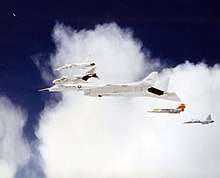
Notable U.S. Air Force pilots who lost their lives in F-104 accidents include Maj. Robert H. Lawrence Jr. and Capt. Iven Kincheloe. Civilian (former USAAF) pilot Joe Walker died in a midair collision with an XB-70 Valkyrie while flying an F-104. Chuck Yeager was nearly killed in December 1963 when he lost control of an NF-104A during a high-altitude record-breaking attempt; he lost the tips of two fingers and was hospitalized for a long period with severe burns after ejecting from the aircraft.[79]
On 2 November 1959, an F-104 crashed into a house in suburban Dayton, Ohio, killing two young girls and critically burning their mother; the pilot had ejected to safety a half-mile away from the crash site.[80]
World records
The F-104 was the first aircraft to simultaneously hold the world speed and altitude records. On 7 May 1958, U.S. Air Force Maj. Howard C. Johnson, flying YF-104A 55-2957, broke the world altitude record by flying to 91,243 feet (27,811 m) at Edwards AFB.[81] On 16 May 1958, U.S. Air Force Capt. Walter W. Irwin, flying YF-104A 55-2969, set a world speed record of 1,404.19 miles per hour (2,259.82 km/h) over a course 15 miles (24 km) long at Edwards AFB.[81] Flying F-104A 56-0762 over NAS Point Mugu, California, U.S. Air Force Lt. William T. Smith and Lt. Einar Enevoldson set several time-to-climb records on 13 and 14 December 1958:[81]
- 3,000 metres (9,800 ft) in 41.85 seconds
- 6,000 metres (19,700 ft) in 58.41 seconds
- 9,000 metres (29,500 ft) in 81.14 seconds
- 12,000 metres (39,400 ft) in 99.90 seconds
- 15,000 metres (49,200 ft) in 131.1 seconds
- 20,000 metres (65,600 ft) in 222.99 seconds
- 25,000 metres (82,000 ft) in 266.03 seconds
On 14 December 1959, U.S. Air Force Captain "Joe" B. Jordan, flying F-104C AF Ser. No. 56-0885 at Edwards AFB, set a new world altitude record of 103,389 feet (31,513 m), in the process becoming the first aircraft to cross the 100,000-foot threshold. He also set a 30,000-metre (98,400 ft) time-to-climb record of 904.92 seconds.[81] (The lower-altitude records were surpassed in February 1962 by the Northrop T-38 Talon, and soon after all of the time-to-climb records were broken by the F-4 Phantom.[82]) U.S. Air Force Maj. Robert W. Smith, flying NF-104A 56-0756, set an unofficial world altitude record of 118,860 feet (36,230 m) on 15 November 1963, and on 6 December 1963 he flew the same aircraft to another unofficial altitude record of 120,800 feet (36,800 m).[81]
Jacqueline Cochran flew TF-104G N104L to set three women's world's speed records: On 11 May 1964, she averaged 1,429.3 miles per hour (2,300.2 km/h) over a 15–25 km (9.3–15.5 mi) course, on 1 June she flew at an average speed of 1,303.18 miles per hour (2,097.26 km/h) over a 100 km (62 mi) closed-circuit course, and on 3 June she recorded an average speed of 1,127.4 miles per hour (1,814.4 km/h) over a 500 km (310 mi) closed-circuit course.[81]
Lockheed test pilot Darryl Greenamyer built an F-104 out of parts he had collected. The aircraft, N104RB, first flew in 1976. On 2 October of that year, trying to set a new low-altitude 3 km (1.9 mi) speed record, Greenamyer averaged 1,010 miles per hour (1,630 km/h) at Mud Lake near Tonopah, Nevada. A tracking camera malfunction eliminated the necessary proof for the official record. On 24 October 1977, Greenamyer flew a 3 km (1.9 mi) official FAI record flight of 988.26 miles per hour (1,590.45 km/h).[83]
On 26 February 1978, Greenamyer made a practice run for a world altitude record attempt. After the attempt, he was unable to get a lock light on the left wheel; after multiple touch-and-go tests at an Edwards Air Force Base runway, he determined that it was not safe to land. He ejected, and the N104RB crashed in the desert.[84]
Variants
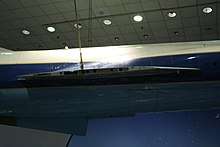
- XF-104
- Two prototype aircraft equipped with Wright J65 engines (the J79 was not yet ready); one aircraft equipped with the M61 cannon as an armament test bed. Both aircraft were destroyed in crashes.[85]
- YF-104A
- 17 pre-production aircraft used for engine, equipment, and flight testing.[7]
- F-104A
- A total of 153 initial production versions were built.[12] The F-104A was in USAF service from 1958 through 1960, then transferred to the Air National Guard until 1963. At that time they were recalled by the USAF Air Defense Command for the 319th and 331st Fighter Interceptor Squadrons. Some were released for export to Jordan, Pakistan, and Taiwan, each of whom used it in combat. The 319th F-104As and Bs were re-engined in 1967 with the J79-GE-19, which provided 17,900 lbf (79.6 kN) of thrust in afterburner; service ceiling with this engine was in excess of 73,000 ft (22,000 m). In 1969, all the F-104A/Bs in ADC service were retired. On 18 May 1958, an F-104A set a world speed record of 1,404.19 mph (2,259.82 km/h).[86]
- NF-104
- Three demilitarized versions with an additional 6,000 lbf (27 kN) Rocketdyne LR121/AR-2-NA-1 rocket engine, used for astronaut training at altitudes up to 120,800 ft (36,800 m).[87]
- QF-104A
- A total of 22 F-104As converted into radio-controlled drones and test aircraft.
- F-104B
- Tandem two-seat, dual-control trainer version of F-104A.[12] A total of 26 built, the F-104B had an enlarged rudder and ventral fin, no cannon, and reduced internal fuel, but otherwise combat-capable. A few were supplied to Jordan, Pakistan, and Taiwan.

- F-104C
- Fighter-bomber version for USAF Tactical Air Command, with improved fire-control radar (AN/ASG-14T-2), one centerline and two wing pylons (for a total of five), and ability to carry one Mk 28 or Mk 43 nuclear weapon on the centerline pylon. The F-104C also had in-flight refuelling capability. On 14 December 1959, an F-104C set a world altitude record of 103,395 ft (31,515 m) (31,515 m). 77 built.
- F-104D
- Dual-control trainer version of the F-104C. 21 built.[12]
- F-104DJ
- Dual-control trainer version of the F-104J for the Japanese Air Self-Defense Force. 20 built by Lockheed and assembled by Mitsubishi. After their retirement in Japan, the U.S. delivered some F-104J/DJs to the Taiwanese Air Force.
- F-104F
- Dual-control trainers based on F-104D, but using the upgraded engine of the F-104G. No radar, and not combat-capable. Produced as interim trainers for the German Air Force. All 30 F-104F aircraft were retired by 1971.
- F-104G
- 1,122 aircraft of the main version produced as multi-role fighter-bombers. Manufactured by Lockheed, and under license by Canadair and a consortium of European companies that included Messerschmitt/MBB, Dornier, Fiat, Fokker, and SABCA. The type featured strengthened fuselage and wing structure, increased internal fuel capacity, an enlarged vertical fin, strengthened landing gear with larger tires, and revised flaps for improved combat maneuvering. Upgraded avionics included a new Autonetics NASARR F15A-41B radar with air-to-air and ground mapping modes, the Litton LN-3 Inertial Navigation System (the first on a production fighter), and an infrared sight.
- RF-104G
- 189 tactical reconnaissance models based on the F-104G,[12] usually with three KS-67A cameras mounted in the forward fuselage in place of the internal cannon.
- TF-104G
- 220 combat-capable trainer versions of the F-104G;[12] no cannon or centerline pylon, and reduced internal fuel. One aircraft was used by Lockheed as a demonstrator with the civil registration number N104L, and was flown by Jackie Cochran to set three women’s world speed records in 1964. This aircraft later served in the Netherlands. A pair of two-seat TF-104Gs and a single-seat F-104G joined the NASA Dryden inventory in June 1975.
- F-104H
- Projected export version based on the F-104G with simplified equipment and optical gunsight. Cancelled prior to construction.
- F-104J
- Specialized interceptor version of the F-104G for the Japanese ASDF, built under license by Mitsubishi for the air-superiority role, armed with cannon and four Sidewinders; no strike capability. Some were converted to UF-104J radio-controlled target drones and destroyed. A total of 210 were built, three by Lockheed, 29 by Mitsubishi from Lockheed-sourced components, and 178 by Mitsubishi.[12][88] After retired in Japan, U.S. delivered some 104J/DJs to the airforce of Taiwan.
- F-104N
- Three F-104Gs were delivered to NASA in 1963 for use as high-speed chase aircraft. One, piloted by Joe Walker, collided with an XB-70 on 8 June 1966.

- F-104S
- 246 Italian versions were produced by FIAT (one aircraft crashed prior to delivery and is often not included in the total number built). Forty aircraft were delivered to the Turkish Air Force and the rest to the Italian Air Force (Aeronautica Militare Italiana).[89] The F-104S was upgraded for the interception role, adding the NASARR R-21G/H radar with moving-target indicator and continuous-wave illuminator for semi-active radar homing missiles (initially the AIM-7 Sparrow), two additional wing and two underbelly hardpoints (increasing the total to nine), the more powerful J79-GE-19 engine, and two additional ventral fins to increase stability. The M61 cannon was sacrificed to make room for the missile avionics in the interceptor version, but retained for the fighter-bomber variants. Typically two Sparrow and two (and sometimes four or six) Sidewinder missiles were carried on all the hardpoints except the central (underbelly), or up to seven 750 lb (340 kg) bombs (normally two to four 500–750 lb [230–340 kg]). The F-104S was cleared for a higher maximum takeoff weight, allowing it to carry up to 7,500 lb (3,400 kg) of stores; other Starfighters had a maximum external load of 4,000 lb (1,800 kg). Range was up to 780 mi (1,260 km) with four tanks.[90]
- F-104S-ASA (Aggiornamento Sistemi d'Arma – "Weapon Systems Update")
- 150 upgraded F-104Ss equipped with the Fiat R21G/M1 radar with frequency hopping and look-down/shoot-down capability, new IFF system and weapon delivery computer, and provision for the AIM-9L all-aspect Sidewinder and Selenia Aspide missiles. It was first flown in 1985.[12]
- F-104S-ASA/M (Aggiornamento Sistemi d'Arma/Modificato – "Weapon Systems Update/Modified")
- 49 airframes upgraded in 1998 to ASA/M standard with GPS, new TACAN and Litton LN-30A2 INS, refurbished airframe, and improved cockpit displays. All strike-related equipment was removed. The last Starfighters in combat service, the F-104S-ASA/M was withdrawn in December 2004 and temporarily replaced by the F-16 Fighting Falcon, while awaiting Eurofighter Typhoon deliveries.
- CF-104
- 200 Canadian-built versions, built under license by Canadair.[12] Optimized for both nuclear strike and 2-stage-to-orbit payload delivery, the CF-104 had NASARR R-24A radar with air-to-air modes, cannon deleted (restored after 1972), additional internal fuel cell, and Canadian J79-OEL-7 engines with 10,000 lbf (44 kN)/15,800 lbf (70 kN) thrust.
- CF-104D
- 38 dual-control trainer versions of CF-104, built by Lockheed, but with Canadian J79-OEL-7 engines.[12] Some were later transferred to Denmark, Norway, and Turkey.
Production summary table and costs
| Type | Lockheed | Multi- national |
Canadair | Fiat | Fokker | MBB[lower-alpha 1] | Messer- schmitt[lower-alpha 1] |
Mitsubishi | SABCA | Total |
|---|---|---|---|---|---|---|---|---|---|---|
| XF-104 | 2 | 2 | ||||||||
| YF-104A | 17 | 17 | ||||||||
| F-104A | 153 | 153 | ||||||||
| F-104B | 26 | 26 | ||||||||
| F-104C | 77 | 77 | ||||||||
| F-104D | 21 | 21 | ||||||||
| F-104DJ | 20 | 20 | ||||||||
| CF-104 | 200 | 200 | ||||||||
| CF-104D | 38 | 38 | ||||||||
| F-104F | 30 | 30 | ||||||||
| F-104G | 139 | 140 | 164 | 231 | 50 | 210 | 188[lower-alpha 2] | 1122 | ||
| RF-104G | 40 | 35 | 119 | 194 | ||||||
| TF-104G (583C to F) | 172 | 27 | 199 | |||||||
| TF-104G (583G and H) | 21 | 21 | ||||||||
| F-104J | 3 | 207 | 210 | |||||||
| F-104S | 245[lower-alpha 2] | 245 | ||||||||
| Total by manufacturer | 738 | 48 | 340 | 444 | 350 | 50 | 210 | 207 | 188 | 2575 |
- 1 2 Messerschmitt merged later to Messerschmitt-Bölkow-Blohm (MBB) later a part of EADS.
- 1 2 One aircraft crashed on test flight and is not included.
| F-104A | F-104B | F-104C | F-104D | F-104G | TF-104G | |
|---|---|---|---|---|---|---|
| Unit R&D cost | 189,473 | 189,473 | ||||
| Airframe | 1,026,859 | 1,756,388 | 863,235 | 873,952 | ||
| Engine | 624,727 | 336,015 | 473,729 | 271,148 | 169,000 | |
| Electronics | 3,419 | 13,258 | 5,219 | 16,210 | ||
| Armament | 19,706 | 231,996 | 91,535 | 269,014 | ||
| Ordnance | 29,517 | 59,473 | 44,684 | 70,067 | ||
| Flyaway cost | 1.7 million | 2.4 million | 1.5 million | 1.5 million | 1.42 million | 1.26 million |
| Modification costs by 1973 | 198,348 | 196,396 | ||||
| Cost per flying hour | 655 | |||||
| Maintenance cost per flying hour | 395 | 544 | 395 | 395 |
Operators

According to the FAA there are 10 privately owned F-104s in the U.S.[92] Starfighters Inc, a civilian demonstration team in Florida, operates three ex-Canadian Military CF-104 Starfighters (1 CF-104D and 2 CF-104s).[93] Another, 5303 (104633), civil registry: N104JR is owned and operated by a private collector in Arizona.[94]
The F-104 was operated by the militaries of the following nations:
Aircraft on display
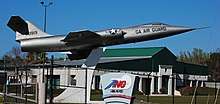
Since being withdrawn from service, the Starfighter has been preserved in museums and is a popular gate guardian.
Specifications (F-104G)
| Lockheed F-104 Starfighter Cutaway | |
|
|
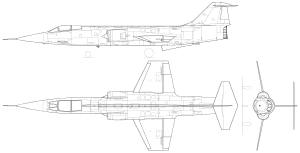
Data from Quest for Performance[95]
General characteristics
- Crew: 1
- Length: 54 ft 8 in (16.66 m)
- Wingspan: 21 ft 9 in (6.63 m)
- Height: 13 ft 6 in (4.11 m)
- Wing area: 196.1 sq ft (18.22 m2)
- Airfoil: Biconvex 3.36% root and tip
- Empty weight: 14,000 lb (6,350 kg)
- Max takeoff weight: 29,027 lb (13,166 kg)
- Powerplant: 1 × General Electric J79 afterburning turbojet, 10,000 lbf (44 kN) thrust dry, 15,600 lbf (69 kN) with afterburner
Performance
- Maximum speed: 1,528 mph; 2,459 km/h (1,328 kn)
- Maximum speed: Mach 2
- Combat range: 420 mi (365 nmi; 676 km)
- Ferry range: 1,630 mi (1,416 nmi; 2,623 km)
- Service ceiling: 50,000 ft (15,000 m)
- Rate of climb: 48,000 ft/min (240 m/s) Initially
- Lift-to-drag: 9.2
- Wing loading: 105 lb/sq ft (510 kg/m2)
- Thrust/weight: 0.54 with max. takeoff weight (0.76 loaded)
Armament
- Guns: 1 × 20 mm (0.787 in) M61A1 Vulcan 6-barreled Gatling cannon, 725 rounds
- Hardpoints: 7 with a capacity of 4,000 lb (1,800 kg),with provisions to carry combinations of:
- Missiles: 4 × AIM-9 Sidewinder
- Other: Bombs, rockets, or other stores
Notable appearances in media
Nicknames
The Starfighter was called the "missile with a man in it", a name swiftly trademarked by Lockheed for marketing purposes, and the press coined the F-104 the Widowmaker due to its high accident rate, but neither were used in service. The term Super Starfighter was used by Lockheed to describe the F-104G in marketing campaigns, but fell into disuse.
In service, it earned a host of nicknames among its users:
- American pilots called it the Zipper or Zip-104 because of its prodigious speed.
- The Japan Air Self-Defense Force called it Eiko (Kanji: 栄光, "Glory").
- In Germany it earned several less-charitable names due to its high accident rate, a common name being Fliegender Sarg ("Flying Coffin"). It was also called Witwenmacher ("Widowmaker"), or Erdnagel ("ground nail"), the official military term for a tent peg.[96]
- The Pakistani Air Force called it Badmash ("Hooligan").
- Among Italian pilots its spiky design earned it the nickname Spillone ("Hatpin"), along with Bara volante ("Flying Coffin").
- Among the Norwegian public and Royal Norwegian Air Force it was affectionately known as Vestfjordoksen ("the Vestfjord bull"), due to the immense roar of the aircraft based in Bodø, at the southern end of Vestfjorden.[97]
- In the Canadian Forces, the aircraft were sometimes referred to as the Lawn Dart and the Aluminium Death Tube due to the high operational losses of 40% of airframes, and Flying Phallus due to its shape. It was affectionally called the Silver Sliver, the Zipper, or Zip, but normally the Starfighter or simply the 104 (one-oh-four).[98]
- NASA's F-104B Starfighter N819NA acquired the nickname Howling Howland due to the unique howling sound of its engine at certain throttle settings.[96]
See also
Related development
- Aeritalia F-104S Starfighter
- Canadair CF-104 Starfighter
- CL-1200 Lancer and X-27
- Lockheed NF-104A
- Lockheed U-2
- Lockheed XF-104
Aircraft of comparable role, configuration and era
- Dassault Mirage III
- English Electric Lightning
- EWR VJ 101
- Mikoyan-Gurevich MiG-21
- Grumman F11F-1F Super Tiger
- Saunders-Roe SR.177
- Sukhoi Su-15
Related lists
References
Notes
- 1 2 Knaack 1978.
- ↑ Blackbirds, Leland R. Haynes, Webmaster, SR-71. "Clarence L. Kelly Johnson Biography".
- 1 2 Bowman 2000, p. 26.
- ↑ Bowman 2000, p. 32.
- ↑ "Sixty years of the Lockheed F-104 Starfighter".
- ↑ "Air Force Puts Supersonic XF-104 Through Its Paces." Popular Mechanics, August 1954, p. 104.
- 1 2 Cacutt 1988, p. 159.
- ↑ "United States Army and Air Force Fighter 1916–1961" produced by D.A. Russell, Harleyford Publications Limited, Letchworth 1961, Library of Congress Card No.61-16739(United States) page 132
- ↑ Matricardi 2006, p. 129.
- 1 2 "Lockheed F-104 Starfighter: The Zipper".
- 1 2 Bowman 2000, p. 28.
- 1 2 3 4 5 6 7 8 9 10 Donald, David, ed. "Lockheed F-104 Starfighter". The Complete Encyclopedia of World Aircraft. New York: Barnes & Nobel Books, 1997. ISBN 0-7607-0592-5.
- ↑ Glenn L. Reaves (March 1961). "Test Pilots Notebook" (PDF). 916-starfighter.de. Lockheed Aircraft Corporation. Retrieved 27 March 2018.
- ↑ "Ejection seats of the F-104." ejectionsite.com. Retrieved: 6 February 2008
- ↑ "M61A1 GAU 4 20-MM Vulcan Cannon". Retrieved 12 July 2017.
- 1 2 "Lockheed F-104 Starfighter Single-Seat High-Speed Fighter / Interceptor Aircraft". 18 June 2017. Retrieved 13 July 2017.
- ↑ "F-104 Starfighter". 2 August 2015. Retrieved 13 July 2017.
- ↑ "Italian F-104 versions explained". 21 April 2009. Retrieved 13 July 2017.
- ↑ Käsmann 1994, p. 84.
- ↑ Bowman 2000, p. 39.
- ↑ "ANG Heritage: Missions, Wars and Operations." Archived 26 November 2014 at the Wayback Machine. ang.af.mil. Retrieved: 8 August 2010.
- ↑ Thompson 2004, p. 155.
- ↑ Thompson 2004, p. 157.
- ↑ Smith and Herz p. 29-35, 67, 68
- ↑ Windle and Bowman p. 38, 39
- ↑ Hobson 2001, p. 23 (photo).
- 1 2 Hobson 2001
- ↑ Hobson 2001, p. 269.
- ↑ "F-104C "60910" 479th TFW USAF based at Udorn RTAFB, Thailand heads into Vietnam 1966, loaded with 2 M-117750 lbs (340 kg) iron bombs, the maximum load at that time." 916-starfighter.de. Retrieved: 6 February 2008.
- ↑ Hobson 2001, p. 24.
- ↑ Hobson 2001, p. 25.
- 1 2 Hobson 2001, p. 32.
- ↑ Hobson 2001, p. 69.
- ↑ Hobson 2001, p. 72.
- ↑ Hobson p. 75
- ↑ Hobson 2001, p. 78.
- ↑ Hobson 2001, p. 85.
- ↑ Hobson 2001, p. 86.
- ↑ Hobson 2001, p. 87.
- ↑ Hobson 2001, p. 100.
- ↑ Fricker and Jackson 1996, p. 74.
- ↑ Jagan and Chopra, 2006.
- ↑ Mohan, Jagan P V S; Chopra, Samir. "3". The India-Pakistan Air War of 1965. ISBN 81-7304-641-7. Archived from the original on 6 July 2013. Retrieved 9 January 2015. .
- ↑ Tufail, Air Commodore M. Kaiser. "Run… It’s a 104." Archived 19 March 2007 at the Wayback Machine. Jang News. Retrieved: 9 April 2012.
- ↑ Coggins 2000, p. 21.
- ↑ Simha, Rakesh Krishnan."The MiG that forced an Army's Surrender". Retrieved: 11 January 2015.
- ↑ "F-104 Starfighters in PAKISTAN AIR FORCE". www.defensejournal.com. Archived from the original on 9 June 2011. Retrieved 25 May 2017.
- ↑ Bowman 2000, p. 165.
- ↑ "Wingless Deterrent." Flight 14 February 1958, p. 95, via flightglobal.com. Retrieved: 27 June 2010.
- ↑ "a Special Correspondent" (17 January 1958), "First Things First: On Not seeing the Sales Trees for the Reorganization Woods." (pdf), Flight, 73 (2556), p. 72, retrieved 27 June 2010 .
- ↑ "The Lockheed Mystery." Time, 13 September 1976. Retrieved: 6 February 2008.
- ↑ Cenciotti, David. "The last ever operative flight of the legendary F-104 Starfighter, 12 years ago today". The Aviationist. The Aviationist. Retrieved 4 July 2017.
- ↑ "Star Lab suborbital launch vehicle: Official unveilong and flight test, October 27, 2011." Archived 29 July 2012 at the Wayback Machine. Star Lab suborbital launch vehicle. Retrieved: 10 August 2013.
- ↑ "Vintage fighters return as launch platforms." citizensinspace.org, 20 March 2012.
- ↑ Boucher, Marc (2015-10-15). "Bloostar and other SmallSat Launchers Look to Fill a Need". spaceref.com. SpaceRef. Retrieved 2016-03-15.
- ↑ Technologies, CubeCab Company Website, Retrieved 15 Feb 2016
- ↑ Dowling, Stephen. "The 1950s jet launching tiny satellites".
- ↑ Launch Services, CubeCab Company Website, Retrieved 15 Feb 2016
- ↑ Yeager and Janos 1985, pp. 278–279.
- ↑ Bowman 2000, pp. 40, 43.
- ↑ Drendel 1976, p. 22.
- ↑ Bowman 2000
- ↑ "Too gung-ho." New Scientist, Vol. 199, No. 2666, 26 July 2008, p. 17.
- ↑ "Trost vom General." Der Spiegel, 13 October 1965.
- ↑ Reed 1981, p. 46.
- ↑ Weal 1995, p. 164.
- ↑ Toliver and Constable 1985, pp. 285–286.
- ↑ Colonel Bruce Jones, USAF (retired)
- ↑ Kropf 2002, Ch. 10.
- 1 2 Germany, SPIEGEL ONLINE, Hamburg. "50 Jahre Starfighter-Kauf: Witwenmacher mit Stummelflügeln – SPIEGEL ONLINE – einestages".
- ↑ The partly fictional German film "Starfighter – Sie wollten den Himmel erobern", between the end of the film and the casting credentials, stated as facts. All the 116 dead pilots, with names and dates of death, were listed on the screen. The film was aired on Danish DR 2, Sunday 23 October 2016
- ↑ Fricker and Jackson 1996, p. 92.
- ↑ Bashow, David. Starfighter, p. 96. Fortress Plubications, 1990.
- ↑ Fricker and Jackson 1996, p. 97.
- ↑ "Spanish F-104 history." Archived 26 February 2012 at the Wayback Machine. aire.org. Retrieved: 9 August 2009.
- 1 2 Bowman 2000, p. 21.
- 1 2 USAF Safety & Inspection Center
- ↑ Jenkins 2005, p. 46.
- ↑ Yeager 1985, pp. 278–284.
- ↑ "Two children die as airplane slams into house after pilot bales out." Ocala Star-Banner, 3 November 1959.
- 1 2 3 4 5 6 "The Starfighter: World Milestones." 916-starfighter.de. Retrieved: 10 August 2011.
- ↑ The T-38 time-to-climb records are ID numbers 8718, 8604, 8599, and 8719 in the FAI database. http://www.fai.org
- ↑ "The Civil F-104 Starfighters". International F-104 Society. Archived from the original on 7 January 2013. Retrieved 14 July 2017.
- ↑ Lednicer, David (22 May 2005). "Lockheed F-104A Starfighter aircraft". airliners.net. Retrieved 14 July 2011.
- ↑ Bowman 2000, p. 35.
- ↑ "F-104 Starfighter." Federation of American Scientists, 29 June 1999. Retrieved: 17 May 2011.
- ↑ Air and Space Magazine: Sky High article. Archived 16 January 2013 at Archive.is
- ↑ Lockheed F-104J Starfighter Retrieved 17 September 2016
- ↑ Matricardi 2006, p. 130.
- ↑ Sgarlato 2004
- ↑ Bowman, Lockheed F-104 Starfighter Bowman 2000, Appendix II.
- ↑ "FAA Registry." Federal Aviation Administration. Retrieved: 23 June 2011.
- ↑ "Starfighters F-104 Demo Team web site." starfighters.net. Retrieved: 6 February 2008.
- ↑ Baugher, Joe. "Lockheed CF-104D Starfighter". American Military Aircraft: Canadair CF-104D Starfighter, 20 January 2003. Retrieved: 24 February 2009.
- ↑ Loftin, LK, Jr. "NASA SP-468: Quest for Performance: The Evolution of Modern Aircraft." NASA. Retrieved: 22 April 2006.
- 1 2 Bashow 1986, p. 16.
- ↑ Helge Andreassen "Nå kan Starfighteren få luft under vingene igjen" (in Norwegian)
- ↑ Bashow, David, "Starfighter", 1990, Fortress Plubications, p 92,93
Bibliography
- Bashow, David L. Starfighter: A Loving Retrospective of the CF-104 Era in Canadian Fighter Aviation, 1961–1986. Stoney Creek, Ontario: Fortress Publications Inc., 1990. ISBN 0-919195-12-1.
- Bashow, David L. "Starwarrior: A First Hand Look at Lockheed's F-104, One of the Most Ambitious Fighters ever Designed!" Wings, Vol. 16, no. 3, June 1986.
- Bowman, Martin W. Lockheed F-104 Starfighter. Ramsbury, Marlborough, Wiltshire, UK: Crowood Press Ltd., 2000. ISBN 1-86126-314-7.
- Cacutt, Len. The World's Greatest Aircraft. New York, NY: Exeter Books, 1988. ISBN 0-7917-0011-9.
- Coggins, Ed. Wings That Stay on. Paducah, Kentucky: Turner Publishing Company, 2000. ISBN 978-1-56311-568-4.
- Donald, David, ed. Century Jets. Norwalk, Connecticut: AIRtime Publishing, 2003. ISBN 1-880588-68-4.
- Drendel, Lou. F-104 Starfighter in action, Aircraft No. 27. Carrollton, Texas: Squadron/Signal Publications, 1976. ISBN 0-89747-026-5.
- Fricker, John and Paul Jackson. "Lockheed F-104 Starfighter". Wings of Fame, Volume 2, 1996, pp. 38–99. London: Aerospace Publishing. ISBN 1-874023-69-7.
- Green, William and Gordon Swanborough. The Great Book of Fighters. St. Paul, Minnesota: MBI Publishing, 2001. ISBN 0-7603-1194-3.
- Higham, Robin and Carol Williams. Flying Combat Aircraft of USAAF-USAF (Vol.2). Manhattan, Kansas: Sunflower University Press, 1978. ISBN 0-8138-0375-6.
- Hobson, Chris. Vietnam Air Losses, USAF, USN, USMC, Fixed-Wing Aircraft Losses in Southeast Asia 1961–1973. North Branch, Minnesota: Specialty Press, 2001. ISBN 1-85780-115-6.
- Jackson, Paul A. German Military Aviation 1956–1976. Hinckley, Leicestershire, UK: Midland Counties Publications, 1976. ISBN 0-904597-03-2.
- Jagan, Mohan P.V.S. and Samir Chopra. The India-Pakistan Air War of 1965. New Delhi: Manohar, 2006. ISBN 81-7304-641-7.
- Jenkins, Dennis R. "Hun Heaven, The Super Sabre Dance." Wings Magazine, Vol. 35, No. 12, December 2005.
- Jenkins, Dennis R. and Tony R. Landis. Experimental & Prototype U.S. Air Force Jet Fighters. North Branch, Minnesota: Specialty Press, 2008. ISBN 978-1-58007-111-6.
- Käsmann, Ferdinand C.W. Die schnellsten Jets der Welt (German language) Planegg, Germany: Aviatic-Verl., 1994. ISBN 3-925505-26-1.
- Kinzey, Bert. F-104 Starfighter in Detail & Scale. Blue Ridge Summit, Pennsylvania: TAB books, 1991. ISBN 1-85310-626-7.
- Knaack, Marcelle Size. Encyclopedia of USAF Aircraft and Missile Systems: Vol. 1, Post-WW II Fighters 1945–1973. Washington, DC: Office of Air Force History, 1978. ISBN 0-912799-59-5
- Kropf, Klaus. German Starfighters. Hinckley, Leicestershire, UK: Midland Counties Publications, 2002. ISBN 1-85780-124-5.
- Matricardi, Paolo. Aerei militari: Caccia e ricognitori, Volume 1. Milan: Mondadori Electa, 2006. No ISBN.
- Nicolli, Ricardo. "Starfighters in the AMI". Air International, Volume 31, No. 6, December 1986, pp. 306–313, 321–322.
- Pace, Steve. Lockheed F-104 Starfighter. St. Paul, Minnesota: Motorbooks International, 1992. ISBN 0-87938-608-8.
- Pace, Steve. X-Fighters: USAF Experimental and Prototype Fighters, XP-59 to YF-23. St. Paul, Minnesota: Motorbooks International, 1991. ISBN 0-87938-540-5.
- Reed, Arthur. F-104 Starfighter – Modern Combat Aircraft 9. London: Ian Allan Ltd., 1981. ISBN 0-7110-1089-7.
- Sgarlato, Nico. "F-104 Starfighter" (in Italian). Delta editions, Great Planes Monograph series, February 2004.
- Smith, Philip E. and Peggy Herz. Journey Into Darkness: the Gripping Story of an American Pow's Seven Years Trapped Inside Red China During the Vietnam War. New York: Pocket Books, 1992. ISBN 0-671-72823-7.
- Stachiw, Anthony L. and Andrew Tattersall. CF-104 Starfighter (Aircraft in Canadian Service). St. Catharine's, Ontario, Canada: Vanwell Publishing Limited, 2007. ISBN 1-55125-114-0.
- Thompson, J. Steve with Peter C. Smith. Air Combat Manoeuvres: The Technique and History of Air Fighting for Flight Simulation. Hersham, Surrey, UK: Ian Allan Publishing, 2008. ISBN 978-1-903223-98-7.
- Thompson, Warren. "Starfighter in Vietnam". International Air Power Review. Volume 12, Spring 2004. Norwalk, Connecticut, USA: AirTime Publishing. 2004. ISBN 1-880588-77-3.
- Toliver, Raymond F. and Trevor J. Constable. Holt Hartmann vom Himmel! (in German) Stuttgart, Germany: Motorbuch Verlag, 1985. ISBN 3-87943-216-3
- Upton, Jim. Warbird Tech – Lockheed F-104 Starfighter. North Branch, Minnesota: Specialty Press, 2003. ISBN 1-58007-069-8.
- USAF Class A mishap rates through the end of 2007. Kirtland AFB, New Mexico: USAF Safety and Inspection Center, 2007.
- van der Zeeuw, Ton. "Lockheed F-104G Starfighter." Vliegend in Nederland 2 (in Dutch). Eindhoven, Netherlands: Flash Aviation, 1987. ISBN 978-90-71553-03-5.
- Weal, John. "Jagdeschwader 'Richthofen': Phoenix Twice Risen". Wings of Fame, Volume 1, 1995, pp. 142–165. London: Aerospace Publishing. ISBN 1-874023-68-9.
- Weaver, Michael E. "Making A Difference: The Tennessee Air National Guard in the Berlin Crisis," The Journal of East Tennessee History 79 (2007), 1–19.
- Yeager, Chuck and Leo Janos. Yeager, An Autobiography. New York: Bantam Books, 1985. ISBN 0-553-05093-1.
- Windle, Dave and Bowman, Martin. Profiles of Flight, Lockheed F-104 Starfighter, Interceptor/Strike/Reconnaissance Fighter. (2011) Pen and Sword, Great Britain. ISBN 978-1-84884-449-0.
External links
| Wikimedia Commons has media related to F-104 Starfighter. |
- Yesterday's Air Force: F-104 Starfighter – United States Air Force
- Lockheed XF-104 to F-104A, F-104B/D, F-104C, and F-104G pages on USAF National Museum site
- The International F-104 Society
- "Super Starfighter" a 1961 Flight article
- Over, under, around and through: Hi-res spherical panoramas of the 'Starfighters Aerospace' fleet
- F-104A in Tennessee Air National Guard Service http://www.teachtnhistory.org/file/Making%20a%20Difference-%20The%20TN%20Air%20National%20Guard%20during%20the%20Berlin%20Crisis,%201961-1962%20(Weaver).pdf
- 916 Starfighter
